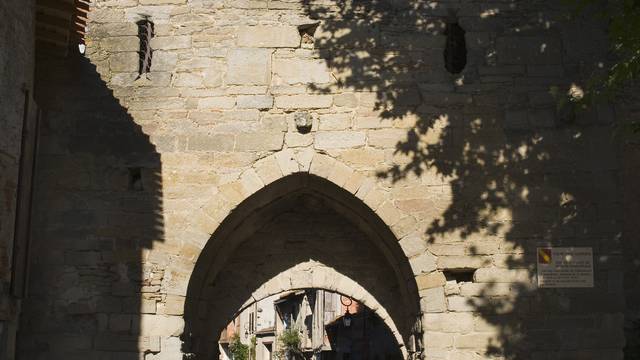History
In the 8th century, hermits founded a Benedictine monastery dedicated to Saint Papoul. The Abbey became famous in the 11th century, thanks to Saint Bérenger, one of its monks. He performed miracles, and pilgrims flocked to see him. In the 12th century, the Abbey asked the Master of Cabestany to sculpt the eastern end of the church. He was a famous sculptor who made a series of modillions and capitals. The Abbey was largely uninvolved in the Albigensian Crusade. It contains the tomb of Jourdain de Roquefort, a great Cathar lord of the Montagne Noire, and received, from his family, the fiefdom of Saint-Papoul. The abbot encouraged the development of the village next to the Abbey. In 1317, Saint-Papoul became a diocese. Afterwards, the pillaging increased. After a period of reconstruction during the 17th century, the Abbey lost the marble fittings from its cloister during the French Revolution. In 1840, it was classed as a historic monument.
Things to explore
As you walk

The 'Pati'
The 'Pati', as it is called by the residents of Saint Papoul, is the big square that separates the episcopal district on one side, and the village on the other. Its recent refurbishment has been designed to restore its possible Medieval aspect: a 14th-century fortified space, separated from the abbey by a ditch crossed by a bridge. You need to cross this lovely open space to enter the citadel.

The village
On the Rue du Général Hautpoul, the Master of Cabestany can be seen - a salvaged snake suddenly appears on a façade. The Rue Bombée is dominated by Classical styles, such as the façades of the 'Lacapelle' house and the 'Maison de la Providence'. The Town Hall rests on arcades which serve as a covered market. Further away, overhanging timber frame buildings lead to the Watchtower.

The Watchtower
This large, squat tower is the only part of the 14th-century fortifications that remains today. It was also used as a prison, and protected the citadel via a portcullis, whose marks can be seen under the archway, where three human heads appear to keep watch. It was classed as a Historic Monument in 1926.
About

Castelnaudary
Known for its 'cassoulet', Castelnaudary offers many other treasures from its long history. Its collegiate church, built in the Southern Gothic style, contains a large Cavaillé-Coll organ from the 18th and 19th centuries. During the One Hundred Year War, the town was razed to the ground by the Black Prince. It was rebuilt during the 16th century under Catherine de Médicis, who had become the Countess of Lauragais, which made her the 'Sénéchaussée' (bailiff), and built the Présidial - a civil and criminal court - which can still be seen today. Next came the 'Grand Siècle' (17th century) and the period of Pierre-Raul Riquet, the great builder of the Canal du Midi. At Castelnaudary, this translated into the construction of the Grand Bassin, whose surface is the same size as the Cité of Carcassonne! This large commercial port, which used to transport grain, is the biggest port along the canal; it would have been full of workers, merchants, and grain waiting to be transported. Today, it is reserved for boaters and hikers searching for a unique place to explore, with spectacular views over the town. (find out more).

Canal du Midi
This extraordinary feat of engineering was built under the supervision of Pierre-Raul Riquet in the 17th century, to link to the Mediterranean to the Atlantic, and was classified as a UNESCO World Heritage site in 1996. 240km of protected riverbanks provide an exceptional setting for pleasure boating, cycling or hiking, or simple Sunday afternoon strolls. The Port de Plaisance at Castelnaudary, close to Saint-Papoul, lets you explore modern life: pleasure-boaters can moor a few hundred metres from the centre of the town, which is famous for its 'cassoulet'. 20 minutes from Saint Papoul, the threshold of Naurouze can tell the story of its origins. It's also a popular picnic spot (find out more).

In the 19th century, Saint Papoul became known for its ceramics, tile-making and glazed pottery. The varnish was obtained from a mineral extracted from the Montagne Noire and ground in the Moulin du Vernis, or the Moulin d'Angel, which can be seen as you leave the village and head towards Villemagne. Four ceramic factories are still in use today, under the directive of the Deputy Mayor, the Marquis Alphonse d'Hautpoul. This Empire General, later a War Minister and President of the Council, is very active in his village, where he has lived his entire life. Today, clay mining continues the industrial and craft tradition of Saint Papoul.




















